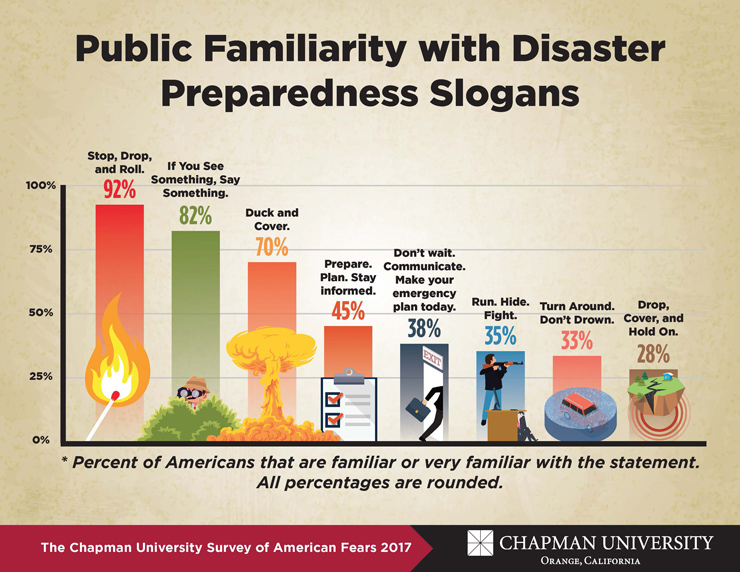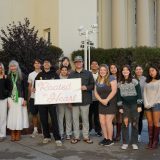America’s Knowledge of Disaster Preparedness Outdated, Dangerous Chapman University Survey of American Fears 2017
October 11, 2017
In our survey we asked a random sample of Americans about FEARS of man-made disasters, such as a nuclear melt-down, and nuclear and terror attacks, as well as natural disasters. We then asked about their familiarity with safety and preparedness advice/slogans [1] .
Nuclear Fears
- Nearly half of all Americans [48%] fear North Korea using nuclear weapons and 41% fear a nuclear attack generally. The prospect of a nuclear meltdown has made 31% afraid or very afraid. Unfortunately, it’s the obsolete, even dangerous, cold war slogan “Duck and Cover” that is familiar to 70% of all Americans.
Americans need to unlearn Duck and Cover and replace it with “Get inside. Stay Inside. Stay Tuned.”
In the event of a nuclear attack or accident, expert advice is to “Go to the basement or the middle of the building. Radioactive material settles on the outside of buildings; so the best thing to do is stay as far away from the walls and roof of the building as you can. If possible, turn off fans, air conditioners, and forced-air heating units that bring air in from the outside. Close fireplace dampers. Bring pets inside. Stay tuned for updated instructions from emergency response officials.”[2]
Thousands or even hundreds of thousands of lives could be saved if the public gets inside to avoid radiation, rather than fleeing or following outdated advice like “Duck and Cover.” Even sheltering in place for 24 hours can make a difference in survival.
Terrorism and Mass Shooting Fears
- Some 48% fear being the victim of terrorism and 44% fear a terror attack in general.
The majority of Americans, 82% are familiar with the slogan, “If you see something, say something.” However, as we reported previously, most Americans are unaware of what constitutes suspicious behavior that should be reported [3].
The fear of being the victim of a mass or random shooting is on the minds of 31%, and some 35% report being familiar with the advice to “Run. Hide. Fight”
Natural Disasters
- Americans fear many natural disasters and 68% believe natural disasters are capable of harming them or their property. Only 38% of Americans have heard the advice “Don’t wait. Communicate. Make your emergency plan today.” Less than half, 41% actually have an emergency plan in place for their households and 26% have such a plan for their pets
- The advice to “Drop, Cover, and Hold On” has reached 28% of Americans, roughly the number who are afraid of earthquakes [25%].
- In a flood, which 23% fear, the advice is to “Turn Around. Don’t Drown.” Some 33% say they are aware of this advice.
- The only advice that has reached nearly every American, some 92%, is “Stop, Drop, and Roll,” if you are on fire. The nation needs to reach this level of awareness for what to do in other disasters and emergencies.
Familiarity With Safety Advice
Whether they’re afraid of an attack by North Korea, a pandemic (which 36% of Americans fear), or a natural disaster, Americans just aren’t prepared. Sheltering in place requires some preparation, such as food water, and medicine. Only 34% of Americans have such preparations, although 45% say they are familiar with the advice to “Prepare. Plan. Stay informed.” And in any disaster a battery powered radio is essential to staying informed. This would be a great step towards preparedness for American households.

Public Familiarity with Safety Advice Disaster Preparedness Slogans
| Preparedness Slogans | Percent of Americans* |
| Don’t wait. Communicate. Make your emergency plan today. | 38% |
| Drop, Cover, and Hold On | 28% |
| Run. Hide. Fight. | 35% |
| Stop, Drop, and Roll | 92% |
| Prepare. Plan. Stay informed. | 45% |
| Turn Around. Don’t Drown. | 33% |
| If You See Something, Say Something | 82% |
| Duck and Cover | 70% |
* Percent of Americans that are familiar or very familiar with the statement. All percentages are rounded.
[1] The slogans discussed here, along with more in depth advice can be found on Ready.gov and emergency.cdc.gov
[2] https://emergency.cdc.gov/radiation/stayinside.asp
[3] CSAF, Wave 3
For more information and articles, visit www.chapman.edu/fearsurvey.

